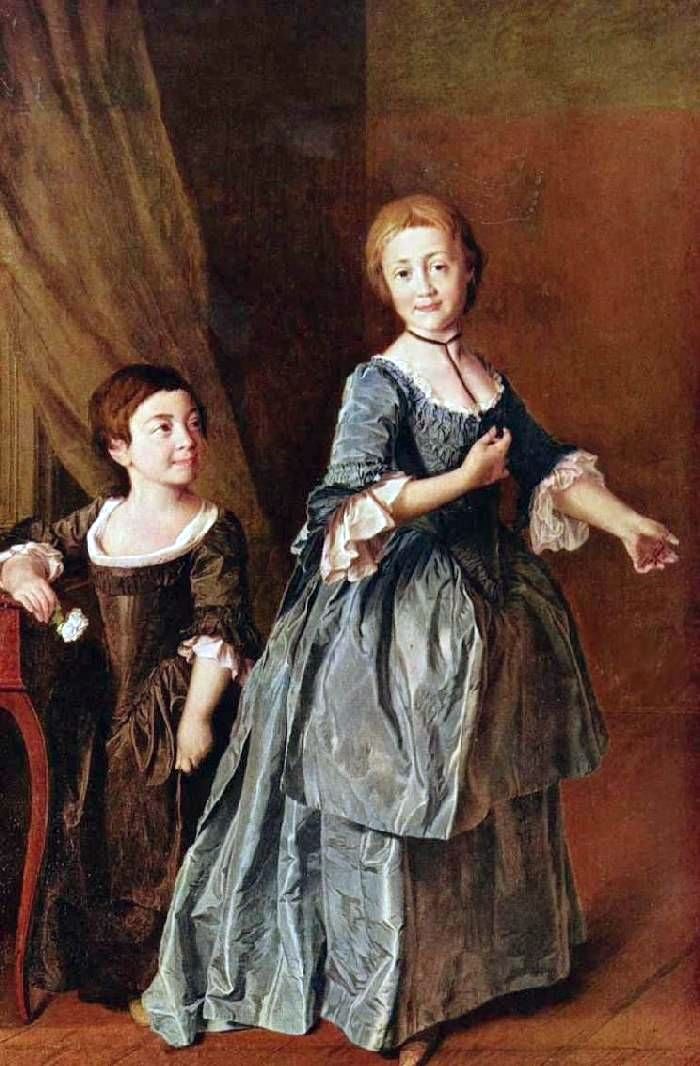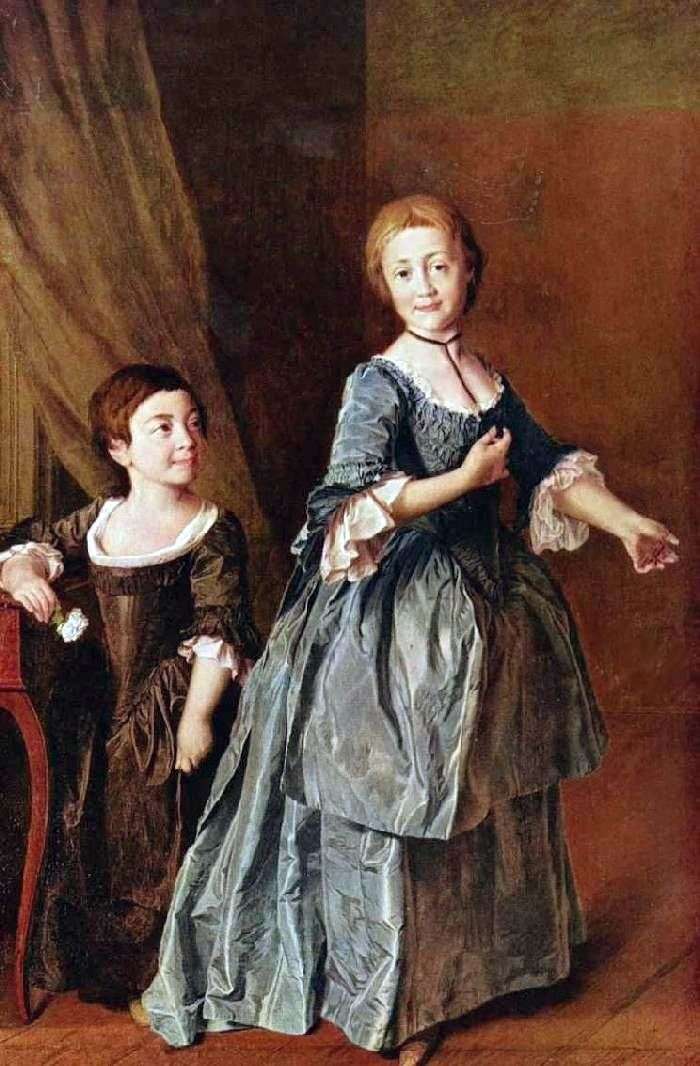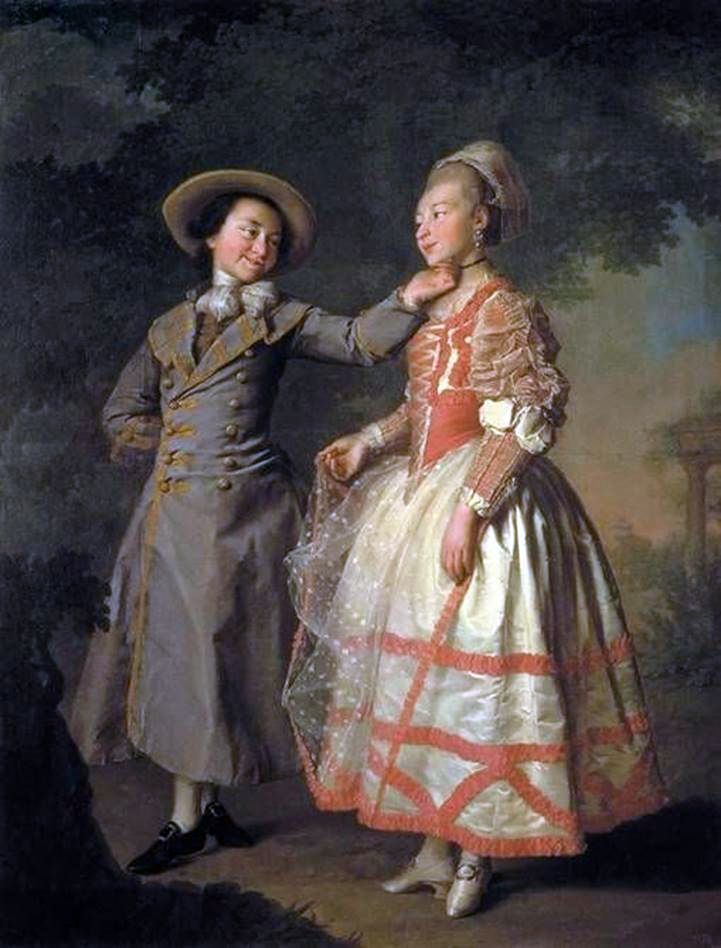
The portrait belongs to the series of portraits of Smolyanok – pupils of the Smolny Institute of noble maidens, written by the artist commissioned by the emperors Catherine II.
F. Rzhevskaya is depicted in a blue uniform dress, established for the second-age pupils of the Educational Society of Noble Maidens; N. M. Davydova is presented in the uniform dress of coffee color, established for the first age.
Theodosius Stepanovna Rzhevskaya is the daughter of Lieutenant-General Stepan Matveevich Rzhevsky and Sofia Nikolaevna, born Baroness Stroganova. A pupil of the Smolny Institute of noble maidens, she married Prince M. N. Golitsyn, a member of the State Duma, a full member of the State Councilor, later the Yaroslavl Governor.
Nastasya Mikhailovna Davydova – Princess. Occurred from the Georgian princely family. Her father, Major General Mikhail Mikhailovich Davydov, was governor of Tambov in the 1780s. Pupil of the Smolny Institute of Noble Maidens,
Strict architectonical construction with all the brightness is found in a simple and “laconic” portrait of Rzhevskaya and Davydova, which does not contain elegant accessories complicating the composition.
If the figures of the girls were presented on a smooth background, devoid of drapery, then the right side of the portrait, containing the larger of them, would outweigh its weight. The drapery, placed on the left side and wedged by a large triangle between the figures, balances the composition, filling the void of the background above the head of the little girl. The lighted part of the curtain with its inclined folds breaks the monotony of the verticals of the figures and the edges of the drapery, dividing the background into two equal parts. Figures of girls turned in different directions at an angle to each other; at the same time, the faces of the two face the central axis of the portrait. This animates the group and makes the viewer feel the reality of the spatial zone that it occupies. Thanks to these techniques, the composition takes a clear, clearly visible character.
In the center of the shallow dark space, indicated by the corner of the table with a bent leg, a curtain and lines of a plank floor running away to the wall, is the figure of an older girl. She poses to the artist, diligently straightening and placing her hands in a dance gesture, thereby, as it were, “pushing off” from the dark part of the space and striving towards its lighter right part. However, a leg peeking out from under the hem of the dress seems to draw an invisible vertical line, which is confirmed by the girl’s face turned towards the viewer. This line of composition contrasts sharply with the general turn of the girl to the right.
The second character of the portrait – the younger girl is also posed for posing: she diligently squeezes the edge of her modestly decorated dress in her fist – her left hand is almost straight and clearly defines the line between the girls’ figures, which, however, somewhat descends to the left in the lower part of the canvas. In the hand laid on the edge of the table is a white rose: a symbol of youth and virtue. However, this whole small figure, despite the need to preserve ceremonial grace, breathes childlike spontaneity, hardly concealed pleasure from posing. Particularly expressive face pupil: she admires looking at his older girlfriend from the bottom up. This look marks one of the special compositional lines of the portrait.
 Portrait de F. S. Rzhevskaya et A. N. Davydova (Smolyanka) – Dmitry Levitsky
Portrait de F. S. Rzhevskaya et A. N. Davydova (Smolyanka) – Dmitry Levitsky Retrato de F. S. Rzhevskaya y A. N. Davydova (Smolyanka) – Dmitry Levitsky
Retrato de F. S. Rzhevskaya y A. N. Davydova (Smolyanka) – Dmitry Levitsky Portrait of E. N. Khrushchova and E. N. Khovanskaya (Smolyanka) by Dmitry Levitsky
Portrait of E. N. Khrushchova and E. N. Khovanskaya (Smolyanka) by Dmitry Levitsky Portrait of Molchanova E. And by Dmitry Levitsky
Portrait of Molchanova E. And by Dmitry Levitsky Portrait of E. I. Nelidova (Smolyanka) by Dmitry Levitsky
Portrait of E. I. Nelidova (Smolyanka) by Dmitry Levitsky Portrait de E. N. Khrushchova et E. N. Khovanskaya (Smolyanka) – Dmitry Levitsky
Portrait de E. N. Khrushchova et E. N. Khovanskaya (Smolyanka) – Dmitry Levitsky Portrait of Praskovya Vorontsova by Dmitry Levitsky
Portrait of Praskovya Vorontsova by Dmitry Levitsky Portrait of Glafira Ivanovna Alymova by Dmitry Levitsky
Portrait of Glafira Ivanovna Alymova by Dmitry Levitsky